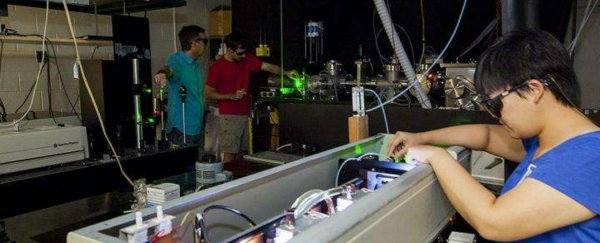Scientists in the US have come up with the first definitive evidence for the existence of a molecule called ethylenedione (or 'OCCO'), which has, until now, been classified as a hypothetical chemical compound. Not only does this discovery solve a mystery that has troubled generations of chemists for over 100 year, but because the molecule is thought to play a role in an array of chemical reactions related to everything from industrial processes to atmospheric chemistry, it offers huge potential for further research.
"We are not talking about some complex compound here. This is a small molecule with only four atoms and an 'obvious' structure. Shouldn't modern science be able to tackle it?" lead researcher Andrei Sanov from the University of Arizona said in a press release. "And yet, it had never been observed, neither as a substance nor as a transient species, despite a century-long history of attempts."
Since the OCCO molecule was first suggested in 1913, scientists have been trying to confirm its existence, but with little success. The most controversial attempt occurred during the 1940s, when Detroit physician William Frederick Koch claimed that he'd not only managed to synthesise the much-sought-after compound, but that it was the active component of a 'wonder drug' called Glyoxylide.
Koch claimed his discovery could cure everything from cancer to diabetes, and although the US Food and Drug Administration (FDA) classified the discovery as fraudulent, the myth of Glyoxylide as an antidote to cancer lives on.
Wonder drug properties aside, we can now confirm that OCCO is real, and its simplistic structure is as beautiful as we could have imagined. You probably even learnt how to write it out if you did chemistry in high school: O=C=C=O. The team says the unstable nature of the molecule is what made it so hard to find, saying it splits into two carbon monoxide (CO) fragments after half a nanosecond or so of existence. This type of transient molecule is called a diradical.
"Radicals and diradicals are all around us," Sanov said. "Think of them as molecules with unpaired electrons that are 'underemployed' and looking for action. This means that they are eager to react, because the making and breaking of chemical bonds is controlled by electrons. A radical is a molecule that has one such 'underemployed' electron. A diradical has two."
The discovery was made in Sanov's lab, when his graduate students were experimenting with glyoxal - a chemical compound with the formula OCHCHO. Until now, potential of the compound as a synthesis molecule has been overlooked, because at 60 percent water, it can be difficult to work with. But Sanov's students figured out how to strip the molecule of its excess water.
"Once we had it in the gas phase so we could analyse it in our mass spectrometer, it turned out to be a good sample to work with, giving nice signal intensity," said doctoral student Andrew Dixon. "We tried to find a name for the molecule that we were making, and a Wikipedia search pulled up ethylenedione. That's when we noticed it was something new."
The results have been published in the journal Angewandte Chemie.
The team will now continue studying the potential of the OCCO molecule, starting with an investigation into its role in atmospheric processes. They say that because glyoxal, OCCO's precursor molecule, plays an important role in atmospheric chemistry, perhaps OCCO does too, and figuring out where it fits in could lead to more accurate climate models.
"One important result of our work is the end of the long-standing controversy surrounding the existence of this molecule," Sanov adds. "The theoretical predictions were correct - the transient OCCO diradical does exist. We have finally found it."
